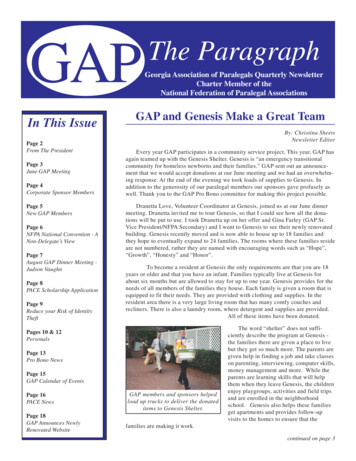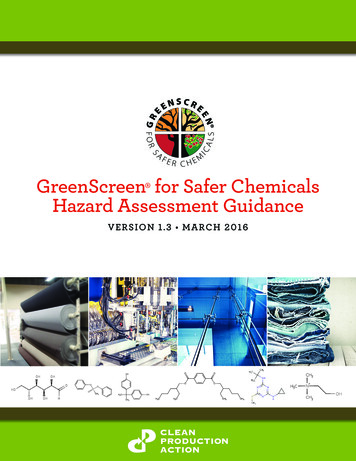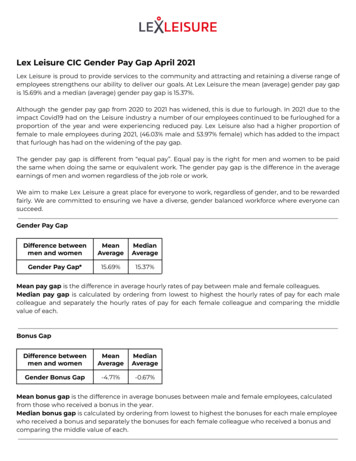
Transcription
(ITEA 2 13017)Enabling of Results from AMALTHEA and othersfor Transfer into Application andbuilding Community aroundDeliverable: D 4.1Gap analysis against ISO 26262Work Package: 4SafetyTask: 4.1Gap analysis of the AMALTHEA development process and tool chainagainst ISO 26262Document Type:DeliverableDocument Version:nalDocument Preparation Date: July 9, 2015Classi cation:PublicContract Start Date: 01.09.2014Duration:31.08.2017
History12.03.2015converted to LaTeX27.04.2015added sections to basics-chapter20.05.2015added content to gap analysis-chapter01.07.2015Major update and review of the entire document.02.07.2015Update according to review comments (from TWT)07.07.2015Update according to review comments (from OFFIS), xed several issues, pre- nal version08.07.2015Minor changes according to review comments (from TWT)09.07.2015Final versioniii
ContentsHistoryiiiSummaryxi1. Basics11.1.Overview of ISO 26262 . . . . . . . . . . . . . . . . . . . . . . . . . . . . .11.1.1.Introduction to phases of ISO 26262. . . . . . . . . . . . . . . . .11.1.2.V-model of ISO 26262. . . . . . . . . . . . . . . . . . . . . . . . .31.1.3.Hazard Analysis and Risk Assessment and ASIL Assignment1.1.4.Safety requirements1.1.5.Traceability . . . . . . . . . . . . . . . . . . . . . . . . . . . . . . .81.1.6.Veri cation Process . . . . . . . . . . . . . . . . . . . . . . . . . . .81.1.7.Safety Validation . . . . . . . . . . . . . . . . . . . . . . . . . . . .9Overview of AMALTHEA . . . . . . . . . . . . . . . . . . . . . . . . . . .91.2. . .3. . . . . . . . . . . . . . . . . . . . . . . . . .61.2.1.The AMALTHEA Meta Model. . . . . . . . . . . . . . . . . . . .91.2.2.Work ow using the AMALTHEA platform . . . . . . . . . . . . . .112. Gap Analysis132.1.Overview of Important Work Products . . . . . . . . . . . . . . . . . . . .132.2.Gap Analysis for Included Work Products16. . . . . . . . . . . . . . . . . .2.2.1.Item de nition2.2.2.Hazard Analysis and Risk Assessment. . . . . . . . . . . . . . . . . . . . . . . . . . . . .2.2.3.Functional Safety Concept . . . . . . . . . . . . . . . . . . . . . . .182.2.4.System Design. . . . . . . . . . . . . . . . . . . . . . . . . . . . .212.2.5.Hardware Design . . . . . . . . . . . . . . . . . . . . . . . . . . . .272.2.6.Software Design . . . . . . . . . . . . . . . . . . . . . . . . . . . . .282.2.7.General Management of Safety Requirements33. . . . . . . . . . . . . . . . . . . . . . . . . . .16183. Relations between the proposed Meta-Model Extensions of AMALTHEA andthe SAFE project353.1.The SAFE project. . . . . . . . . . . . . . . . . . . . . . . . . . . . . . .3.2.SAFE Parts in the Scope of AMALTHEA4public3.3.Expected Results from the SAFE Project4. Conclusion35. . . . . . . . . . . . . .35. . . . . . . . . . . . . . . . . .3839v
ITEA 2 13017Gap analysis against ISO 26262D 4.1 nalA. Appendix41A.1. ISO 26262 Work Products Excluded from Gap Analysisvi. . . . . . . . . .41
List of Figures1.1.Overview of the ISO 26262 development process (source: [4])1.2.Derivation of Safety Requirements (source: [5])1.3.Structure of safety requirements (source: [5])1.4.Dependencies of the AMALTHEA models3.1.Overview of SAFE Work Packages (source: [11])3.2.Overview of the Coverage of ISO 26262 in SAFE (source: [11])vii. . . . . . .2. . . . . . . . . . . . . . .4. . . . . . . . . . . . . . . .5. . . . . . . . . . . . . . . . . .11. . . . . . . . . . . . . . . . . . .3637
List of Tables2.1.ISO 26262 work products2.2.ISO 26262 work productsincludedpartially includedin the gap analysis. . . . . . . . . . .in the gap analysis14. . . . . .152.3. Work Products and Requirements for the Item De nition . . . . . . . . . .162.4. AMALTHEA Requirements: Item De nition . . . . . . . . . . . . . . . . .172.5. Work Products and requirements for the HARA . . . . . . . . . . . . . . .182.6. Work Products and Requirements for the Functional Safety Concept . . . .182.7. AMALTHEA Requirements: Safety Goals. . . . . . . . . . . . . . . . . .192.8. AMALTHEA Requirements: Functional Safety Concept . . . . . . . . . . .202.9. Work Products and Requirements for the System Design22. . . . . . . . . .2.10. AMALTHEA Requirements: Technical Safety Requirements Speci cation232.11. AMALTHEA Requirements: Technical Safety Concept . . . . . . . . . . .252.12. AMALTHEA Requirements: System Design Speci cation25. . . . . . . . .2.13. AMALTHEA Requirements: Hardware-Software Interface Speci cation.25tural Information . . . . . . . . . . . . . . . . . . . . . . . . . . . . . . . .262.14. AMALTHEA Requirements: ASIL Decomposition / Update of Architec2.15. AMALTHEA Requirements: ASIL Decomposition / Update of ASIL asAttribute of Safety Requirements . . . . . . . . . . . . . . . . . . . . . . .262.16. AMALTHEA Requirements: Coexistence of Elements / Update of ASILas Attribute of Sub-Elements of Elements. . . . . . . . . . . . . . . . . .2.17. Work Products and Requirements for the Hardware Design26. . . . . . . .272.18. AMALTHEA Requirements: Hardware Safety Requirements Speci cation282.19. AMALTHEA Requirements: Hardware Design Speci cation . . . . . . . .282.20. Work Products and Requirements for the Software Design . . . . . . . . .282.21. AMALTHEA Requirements: Software Safety Requirements Speci cation .312.22. AMALTHEA Requirements: Software Architectural Design Speci cation .322.23. AMALTHEA Requirements: Software Unit Design Speci cation. . . . .32. . . .332.24. AMALTHEA Requirements: Management of Safety Requirementsix
SummaryThis document describes gaps of the AMALTHEA platform with regards to the international safety standard ISO 26262 [3] addressing the development of electric/electronicsystems for road vehicles.Taking into account the current state of AMALTHEA andbased on a thorough analysis of the safety standard, the gaps in AMALTHEA with respect to ISO 26262 were documented in the form of requirements for the AMALTHEAmeta-model.The analysis takes into account the application scope of AMALTHEA and excludesparts of ISO 26262 that are not relevant in this context, like, e.g.hardware develop-ment. Work products and their associated requirements de ned in the safety standardwere aligned with the AMALTHEA meta-model which we consider to be the core element of the AMALTHEA platform to identify gaps. Based on the gaps identi ed, theAMALTHEA meta-model can be adapted and extended to better support the ISO 26262compliant design and development of safety-relevant embedded software.xi
1. Basics1.1. Overview of ISO 26262The international standard ISO 26262 is a safety standard with the general title Roadvehicles - Functional safety . It was published in 2011, based on the functional safetystandard IEC 61508, which deals with safety of electrical and electronic (E/E) systemssystems in every area of industry. Instead, ISO 26262 concentrates on the developmentof E/E systems of passenger cars with a maximum gross vehicle mass up to 3500 kg. It isexpected that future versions or extensions of the standard will have a greater coverageand also include vehicles like trucks and motorcycles.ISO 26262 describes the safety life-cycle of automotive E/E systems, including management, development, production, operation, service and decommissioning. A centralAutomotive Safety Integrity Levels (ASILs)element is the hazard analysis and risk assessment in the beginning of the safety lifecycle, where so-calledare de ned. Based onthis classi cation, requirements for avoidance of unreasonable residual risk are de nedand validation methods are recommended or prescribed.In addition, intended relations with suppliers and other stakeholders are described,Safety Elements out of Contextwhich helps to support integration of an item at product and vehicle level.end, the concept ofFigure 1.1 provides an overview of the di erent parts of ISO 26262.1.1.1. Introduction to phases of ISO 26262The international standard ISO 26262 consists of the following ten parts:1. Vocabulary2. Management of functional safety3. Concept Phase4. Product development at the system level5. Product development at the hardware level6. Product development at the software level7. Production and operation8. Supporting processes1To this(SEooC) is de ned in the standard.
ITEA 2 13017Gap analysis against ISO 26262D 4.1 nalFigure 1.1.: Overview of the ISO 26262 development process (source: [4])2
D 4.1 nalGap analysis against ISO 26262ITEA 2 130179. ASIL-oriented and safety-oriented analyses10. Guideline on ISO 26262Each part is subdivided into di erent phases. The rst part contains a glossary for theused vocabulary and Part 10 is just informative. Thus, in the following we will focus onParts 2 to 9.Part 2, management of functional safety, de nes which role safety has to play in theoverall development process of a product.It is divided into the phases of the overallsafety management, safety management during the concept and product developmentphases as well as safety management after the item's release for production.Based on the concepts de ned in the second part, Parts 3 to 7 adopt the V-model asguideline through the conception and development process of a product, to the point ofproduction and operation. Parts 8 and 9 contain more criteria and rules that have to beapplied during the safety life-cycle of a product, for example how requirements have tobe de ned and which attributes they must have.1.1.2. V-model of ISO 26262Parts 3 to 7 of ISO 26262 adhere to the V structure.During concept phase, productdevelopment and operation a continuous veri cation and validation of the design processand the implementation is required.Part 3 addresses the concept phase and de nes the technical safety concept, the itemde nition, the initiation of the safety life-cycle and hazard analysis and risk assessment.The safety life-cycle covers the entirety of phases from the initial concept to the decommissioning of an item. The role of the hazard analysis and risk assessment is describedin the following Section 1.1.3.The product development at the system level (Part 4) is split into two sections, whererst the initiation of the product development at the system level, the speci cation ofthe technical safety requirements and the system design have to be performed. This isfollowed by the parallel product development at hardware and software levels in Parts5 and 6. Each development process goes from initiation via design and/or implementation to testing, integration and veri cation of the underlying safety requirements. Afterhardware and software development, item integration and testing, safety validation, functional safety assessment and release for production are again conducted at system level(Part 4).Finally, ISO 26262, Part 7 describes the process of production, operation, service anddecommissioning.1.1.3. Hazard Analysis and Risk Assessment and ASIL AssignmentWithin the concept phase, a hazard analysis and risk assessment (HARA) needs to beperformed. To point out the importance of this method for the rest of the ISO 26262,we brie y describe the recommended process in the following.3
ITEA 2 13017Gap analysis against ISO 26262D 4.1 nalFigure 1.2.: Derivation of Safety Requirements (source: [5])The development process of an item1 starts with the concept phase, where the itemneeds to be de ned and relations to other items have to be described. Also the intendedbehaviour of the item should be de ned. Based on this, possibly hazardous events involving the item must be identi ed and classi ed. This is already part of the HARA.Depending on the evolved classi cation, ASILs can be determined. The risk classi cationusing ASILs can be derived by the parameters severity, the exposure and the controllability of a hazardous event. There are four ASILs from the lowest level A to the highestlevel D, supplemented by the level QM, which stands for (standard) quality management.To each hazardous event with an ASIL, asafety goalshould be formulated within thephase of HARA. It has to be veri ed, that the set of hazardous events is complete, that itfunctional safety requirementsfunctional safety conceptcomplies with the item de nition and the determination of ASILs is consistent. From thesafety goals,are derived. They inherit the ASILs assignedto the corresponding hazardous event/safety goal. This process is depicted in Figure 1.2and part of the. The functional safety requirements also de nesafety measures and mechanisms to enable fault detection, failure mitigation and faulttolerance mechanisms and ensure the transition to a safe state (in case of a fault).technical safety require-The functional safety requirements are later allocated to individual design elements atmentssystem, hardware and software levels and re ned into so-calledtaking into account a preliminary system design. This is happening within the rstphases of Parts 4, 5 and 6 of ISO 26262, which constitute the kernel of the developmentof a new product. Every following step in the development of the system at system, hardware or software level shall comply with the allocated safety requirements. An overviewof the process and the corresponding parts of the standard is given in Figure 1.3.1An item is representing an E/E system.4
D 4.1 nalGap analysis against ISO 26262ITEA 2 13017Figure 1.3.: Structure of safety requirements (source: [5])5
ITEA 2 13017Gap analysis against ISO 26262D 4.1 nal1.1.4. Safety requirementsAs described in Part 8 of ISO 26262, safety requirements have to satisfy certain properties.They have to be allocated to some item or element, having the following characteristics: unambiguous and comprehensible atomic internally consistent feasible veri ableand attributes: a unique identi cation a status (e.g. proposed, assumed, accepted, reviewed or realised) an ASILFurther, the set of safety requirements shall have a hierarchical structure, which allows traceability, and has to be complete, externally consistent and maintainable. Bidirectional traceability shall be established from safety requirements on di erent levelsof abstraction, to their realisation in the design and the speci cation of their veri cation.There are di erent types of safety requirements described in ISO 26262: functional safety requirements (derived from the safety goals the top-level requirements and allocated to the preliminary architectural elements) technical safety requirements: hardware safety requirementssoftware safety requirementsTechnical Safety RequirementsFrom the functional safety concept, technical safety requirements are derived. This happens in accordance with further architectural assumptions, e.g.constraints, externalinterfaces or system con guration requirements. The main task of technical safety requirements is to specify safety-related dependencies between systems or item elementsand between the item and other systems. They have to be allocated directly or by further re nement to hardware or software. This means, that the technical safety conceptprovides a statement of how the functional safety concept is implemented in softwareor hardware.On the other hand, the system has to comply with the technical safetyconcept. As shown in Figure 1.3 hardware and software requirements are derived fromtechnical safety requirements depending on their allocation.The technical safety concept comprises the following aspects that have an impact onboth, software and hardware requirements and design:6
D 4.1 nalGap analysis against ISO 26262 speci ed system and hardware con gurations hardware-software interface speci cation relevant requirements of the hardware design speci cation external interfacesITEA 2 13017Hardware Safety RequirementsTechnical safety requirements, which are allocated to hardware, are the basis for hardwaresafety requirements. Attributes of safety mechanisms, that handle internal and externalfailures of components and requirements of other components have to be taken into account. Corresponding hardware components inherit the highest ASIL from the hardwaresafety requirements, that are allocated to it. It has to be ensured, that the traceabilitybetween hardware safety requirements, derived requirements and their implementationis maintained down to the lowest level of hardware components. This implies, that wecan also have requirements and ASILs on e.g. single processors, cores or memory cells.Software Safety RequirementsAnalogously, software safety requirements are based on the technical safety requirements,which are allocated to software.In addition to the general properties of requirementsand the system properties that have an impact on software (as speci ed in the technicalsafety concept; see above), further aspects shall be considered: timing constraints operating modes of the vehicle, system or hardware, that have an impact on thesoftwareLike hardware components, software components have associated ASILs, that are inherited from the highest ASIL of a requirement, that is allocated to the component.Traceability needs to be ensured down to the level of software units.ASIL Decomposition and InheritanceIt is possible to conduct an ASIL decomposition during the re nement and allocationprocess of safety requirements.This enables decomposing a safety requirement intoredundant architectural elements (represented by derived safety requirements) and toassign a potentially lower ASIL to the decomposed safety requirements.The precisedecomposition scheme can be found in Part 9 of the ISO 26262 standard.Each hardware and software component inherits the highest ASIL of the safety requirements it implements. This implies that the following artefacts are all attributed with anASIL: safety requirements (see above)7
ITEA 2 13017Gap analysis against ISO 26262 systems and subsystems hardware components software components interfacesD 4.1 nal1.1.5. TraceabilityAccording to ISO 26262, Part 8, each safety requirement must be traceable with referencesto its source at the next higher level of abstraction (the requirement or safety goal itwas derived from) derived safety requirements at a lower level of abstraction or its decomposition (ifapplicable) the realisation of the requirement in the design of the system (if it is a leaf in the requirements tree ) the speci cation of veri cation (especially, if it is a leaf in the requirements tree ) the implementation of safety requirements down to the lowest hardware level (forhardware safety requirements) the realisation of safety requirements in software units in the software architecturaldesign (for software safety requirements)Safety requirements shall be placed under con guration management to enable thetracking of changes and reference baselines. Safety requirements at lower levels of abstraction shall reference a valid baseline of higher level requirements to ensure consistency.1.1.6. Veri cation ProcessISO 26262 de nes three steps of veri cation that have to be carried out in each phase ofVeri cation planningthe safety life-cycle:addresses the content of the work products to be veri ed, themethods used for veri cation, pass and fail criteria, the environment in which the veri cation is conducted and the tools used. In addition, actions to be taken if veri cationfails, need to be de ned. The planning should consider adequacy of methods and tech-veri cation planveri cation speci cationnologies used for veri cation, the complexity of the work products under veri cation andprior experiences. The result of this step is aThe purpose of the following.is to select and specify methodsused for the veri cation and shall include all necessary con gurations and test cases indetail (test inputs, execution sequences, environmental conditions, etc.).8
D 4.1 nalGap analysis against ISO 26262ITEA 2 13017veri cation execution and evaluationFinally, the veri cation is carried out (tion reportveri ca-) accordingto the veri cation plan and speci cation and the results are documented in the. The veri cation speci cation and report shall clearly reference all relevantrequirements (which in turn have to enable tracing of the veri cation artefacts).1.1.7. Safety ValidationValidation in the sense of ISO 26262 is conducted to provide evidence that the functionalsafety concept is appropriate for the functional safety of the developed item. In addition, the correctness and completeness of the safety goals themselves and their completecoverage at vehicle level has to be proven.The validation step is based on the results on hazard and risk analysis and the veri cation results at system level after item integration providing the evidence that the safetygoals have been implemented correctly.In particular, controllability validation usingoperating scenarios, validation of the e ectiveness of the safety and external measuresas well as elements implemented in other technologies (e.g. mechanical) shall be carriedout.1.2. Overview of AMALTHEAThe AMALTHEA tool platform is a model-based open source development environmentfor automotive systems which was developed in an ITEA2 funded project running from2011 to 2014. The AMALTHEA platform addresses the following aspects: multi-core systems product line engineering con guration of automotive software systems handling of big data volumes continuous tool chain conformity to standardsThe main focus of this document is to examine the last point of this listing with regardsto the automotive safety standard ISO 26262.1.2.1. The AMALTHEA Meta ModelAMALTHEA's main contribution is the meta-model based on Ecore [1] that consists ofthe following sub-models: Hardware model: Describes hardware systems which usually consist of ECUs, microcontrollers, cores, memories, additional peripherals etc.9
ITEA 2 13017 Gap analysis against ISO 26262D 4.1 nalSoftware model: Describes the structure and dependencies of embedded softwarecomponents including data types, labels representing memory locations, runnables,tasks and activations. Constraints Model: De nes di erent kind of constraints. There are the runnablesequencing-constraints that can be used to de ne a required order for the runnablesof the software model, the a nity constraints for de ning the constraints for themapping of runnables, processes and schedulers, and the timing constraints forrestricting the time span between events or the duration of event chains. Event Model:The event model provides the classes to describe system eventsaccording to the Best Trace Format (BTF). The model can be used for the tracingcon guration, for the modelling of event chains and for some timing constraints. Mapping Model: The mapping model is intended to provide tools that use hardwareand software models (e.g. code generators) information about the correspondingmappings and allocations. This information contains associations between schedulers and executable software, schedulers and cores as well as data and memories. OS Model: Describes the provided functionality of an operating system. It mainlyprovides a way to specify how access is given to certain system resources. Thereforethe concepts of scheduling, bu ering, and semaphores are supported. Property Constraints Model:The purpose of this model is to limit the designspace by providing information about the speci c hardware properties that partsof the software rely on, i.e.what properties or features have to be supplied bythe respective hardware in order to be a valid mapping or allocation target. Thisinformation comprises allocation const
Figure1.1provides an overview of the di erent parts of ISO 26262. 1.1.1. Introduction to phases of ISO 26262 The international standard ISO 26262 consists of the following ten parts: 1.oVcabulary 2.Management of functional safety 3.Concept Phase 4.Product development at the system level 5.Product development at the hardware level











